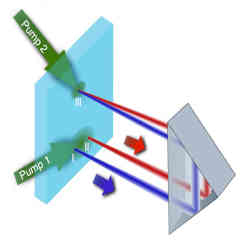
Optical signals transport Internet data between cities, between datacenters, and even to end-users subscribing to fiber-optic Internet Service Providers (ISPs). Optical signals also connect the servers in supercomputers because they travel at the speed of light (actual data transmission processing speeds of optical signals have been measured by Bell Labs at more than 100 petabits per second per kilometer via micron-sized optical fibers). Optical technologies require a fraction of the power used by corresponding electronic equipment, as optical technology uses massless, frictionless photons to carry data, instead of friction-prone, heat-producing electrons.
Those virtues have been incorporated into a new breed of room-temperature optical transistors, which also can compute.
Researchers at IBM Research Zurich, in collaboration with colleagues at the U.K.'s University of Southampton and Germany's Universität Wuppertal, published an article in the June Nature Photonics that described sub-pico-second optical transistor switching speeds (compared to electronic transistor switching speeds of nanoseconds, more than 1,000 times slower), as well as amplification for wide fan-out, cascadable logic operations. The researchers said they accomplished such all-optical logic gates through the use of organic materials sandwiched between layers of silicon/tantalum dielectrics.
"This type of light switch could provide the basic building blocks for optical circuits and even optical computers," said Zheng Sun, a physicist at the University of Pittsburgh who did not work on the project.
The researchers said their room-temperature optical transistors performed all-optical AND and OR logical operations. They added that once IBM has achieved its next step (a universal NOR gate from which any logical operation can be configured), all-optical computing at terahertz frequencies will be possible.
IBM's all-optical transistor is a relatively bulky prototype (compared to today's nanoscale electronic transistors, which are 1,000 times smaller). However, optical transistors operate at frequencies in the terahertz (THz) region, compared to the 1,000-times-slower GHz range for today's electronics.
"We are hoping to inspire other teams to work on making all-optical routers and other uses that today require an expensive and bulky optical-to-electrical-to-optical converter," said Thilo Stoeferle, a physicist at IBM Research Zurich. "An all-optical computer is still only a dream, but there are many other all-optical operations using discrete devices that could be realized in the mean time."
How It Works
The optical transistors are not powered by electricity, but by pumped lasers; that is, violet laser beams (at the 400-480-nanometer wavelength) continuously modulate between high- and low-power outputs, which are interpreted as logical 1s and 0s. A second, smaller laser beam—functioning in lieu of an electronic gate—switches the pumped laser on and off to produce the desired output of 1s and 0s.
The pumped laser (acting as the optical transistor's power supply) creates hot excitons—bound electrons and electron holes too energetic to recombine—in the central 35-nanometer-thick polymer of the optical material, which is sandwiched between 50-nanometer layers of transparent silicon dioxide (which act as optical cavities). The multiple sandwiched layers of tantalum oxide/silicon dioxide act as face-to-face internal mirrors (Bragg reflectors) atop a glass substrate.
The hot excitons bounce between the mirrored layers in the cavity at the speed of light so quickly that they vibrate the crystalline lattice to the extent that light waves and vibrations can no longer be distinguished. This quantum phenomenon, called a polariton, arises from the strong coupling of the electromagnetic oscillations of the dipolar excitons in the cavity provided by the silicon dioxide. When the control laser beam (the gate) alights on the same spot as the pumped laser beam, it causes the emission of a single quantum of vibrational energy—a vibron—which in turn allows a photon from the pumped laser to emit an output beam identical to the control signal, but amplified.
Since the control beam is more precise in both wavelength and angle of incidence, it induces an avalanche of this quantum effect called a Bose-Einstein condensate, which will continue as long as the gated control beam is active. When the control beam ceases, the optical transistor shuts off its output.
Explains IBM Research physicist Rainer Mahrt, "The pump beam is like the power supply for an electronic circuit. The control signal performs the gating function. The output of one optical transistor cascades to the control input to the next optical transistor usually being reflected off a mirror."
In the end, the theoretically maximum amplification factor is a whopping 6,000, at least 10 times larger than similar optical amplifiers.
Besides a universal NOR gate, the researchers are also working on horizontal emission within the plane of the material, full integration, and a new type of in-plane ultra-compact delay line.
R. Colin Johnson is a Kyoto Prize Fellow who has worked as a technology journalist for two decades.



Join the Discussion (0)
Become a Member or Sign In to Post a Comment